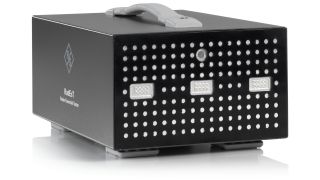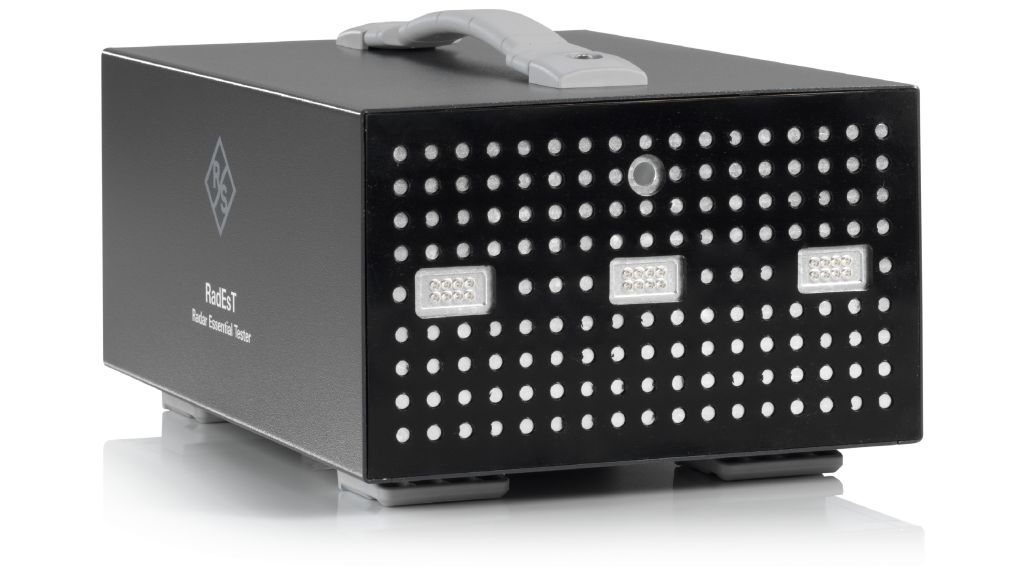Revolutionizing EOL radar sensor alignment and calibration during OEM production
R&S®RadEsT – electronic corner reflector

R&S®RadEsT – electronic corner reflector


Compact and lightweight R&S®RadEsT radar essential tester: Dimensions (W × H × D): 186.5 mm × 138.6 mm × 275 mm (7.34 in × 5.46 in × 10.83 in) Weight: 3.2 kg (8 lb)
Your task
In the fast-paced automotive industry, aligning and calibrating radar sensors efficiently during OEM end-of-line (EOL) production is more than a technical requirement; it is a critical step in ensuring safety, reliability and customer satisfaction. Traditional calibration methods often rely on passive elements such as metal plates, corner reflectors and mechanical moving Doppler generators. These methods have significant drawbacks: they require too much space, lack flexibility and repeatability, and are prone to noise interference. The challenge is to seamlessly meet the calibration needs of advanced radar sensor generations while optimizing throughput and precision.


Integration in OEM ADAS calibration and alignment test stand
Application
In modern vehicles, radar sensors are critical components for advanced driver assistance systems (ADAS) such as adaptive cruise control, collision avoidance and lane keeping assist. Proper alignment and calibration of these sensors is essential to ensure optimal performance and safety on the road.
Misaligned or improperly calibrated radar sensors can lead to inaccurate object detection, delayed response times and false warnings, compromising the vehicle's ability to accurately interpret its surroundings. This can increase the risk of accidents, particularly at high speeds or in complex traffic conditions.
As vehicle manufacturers implement higher ADAS levels and integrate next generation imaging and distributed radar sensors, more demanding alignment and calibration procedures are required. We approach the limitations of what can be achieved using passive elements.
Rohde & Schwarz solution
The R&S®RadEsT radar essential tester is a compact, cutting-edge radar target simulator that revolutionizes radar sensor alignment and calibration by offering an unprecedented range of capabilities. Designed to simulate both static and dynamic radar objects, the R&S®RadEsT provides unmatched precision, configurability and efficiency for EOL processes, empowering OEMs to stay ahead of the competition in a highly contested market.
Key advantages
Summary
The R&S®RadEsT is not just a calibration tool; it is a comprehensive solution for modern radar sensor alignment and testing. By replacing outdated passive elements with a compact, versatile and future-proof system, the R&S®RadEsT ensures compatibility with next generation radar technologies while optimizing space, throughput and accuracy. Its innovative design and flexible configurability make it an indispensable asset for OEMs looking to excel in a competitive and safety-critical market.
Comparison of passive elements versus the R&S®RadEsT
| Passive elements | R&S®RadEsT |
|---|---|
| Metal plates, corner reflectors and Doppler generators | Static and dynamic artificial object generation |
|
No modification of parameters Cannot qualify advanced parameters of newer radar sensor generations |
Modification of radar parameters: distance, Doppler effect, RCS and angle Can qualify advanced radar sensor parameters of newer radar sensor generations |
| Requires around 10 m2 of floor space | Requires around 1 m2 of floor space |
| Accurate positioning is difficult | Antenna systems allow flexible positioning |
| Unstable due to external noise | Small footprint with shielded environment to minimize external noise |
| Doppler generators become inaccurate over lifetime | Self-check capability of the R&S®RadEsT ensures accuracy over lifetime |
| Further tests possible, e.g. EIRP and occupied bandwidth | |